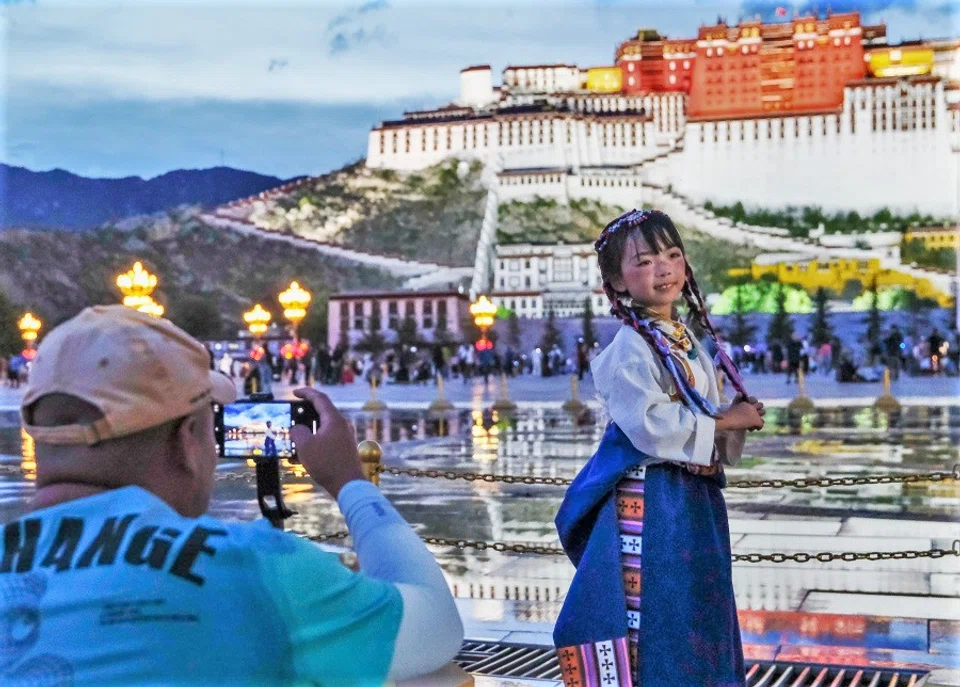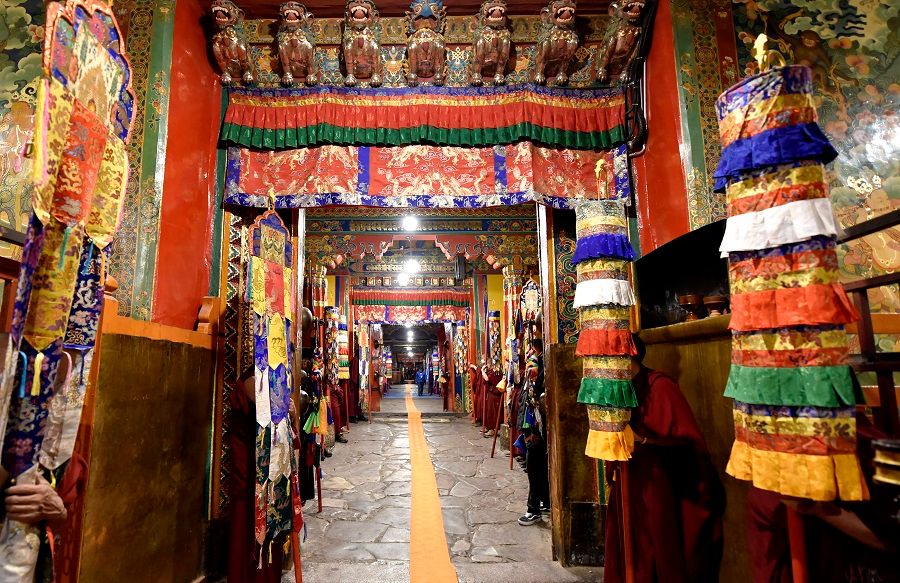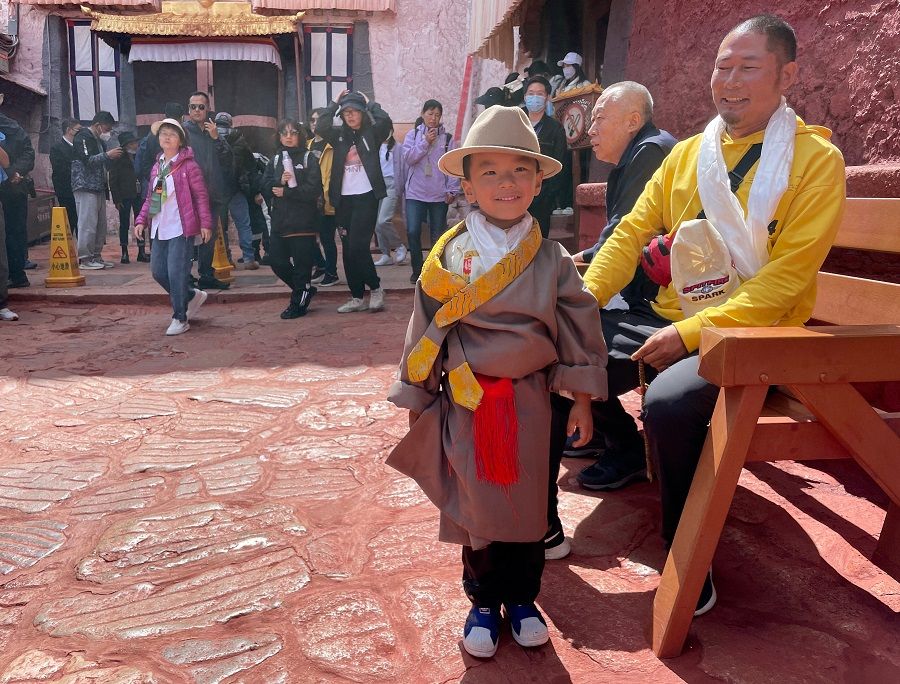[Video] Tibet aims to boost tourism but not at the expense of security

As I stepped into the 1,300-year-old structure known as the Potala Palace, I saw Tibetan Buddhist believers in traditional clothing prostrating themselves on the ground. Less than a metre away, a guide in traditional Tibetan clothing was explaining the history of Potala Palace to a dozen tourists over a microphone. The narrow walkways were packed shoulder to shoulder, and only a thin rope separates the daily life of the Tibetans from the economic activities of tourism.
Tourism taking off post-pandemic
Tourism is an important pillar industry in Tibet autonomous region, with tourism revenue accounting for nearly one-third of the region's GDP. Affected by the Covid-19 pandemic, last year Tibet received the lowest number of tourists in five years, with figures dropping from 41.5 million in 2021 to 30 million in 2022. Its total tourism revenue even plummeted to 40.7 billion RMB (US$5.6 billion), a decline of over 27% compared with pre-pandemic levels.
Tibet received a total of 2.55 million domestic and foreign tourists in the first quarter of this year, and generated 2.03 billion RMB in tourism revenue, surpassing pre-pandemic levels in 2019.
After China relaxed its anti-Covid measures, Tibet set a GDP growth target of about 8% this year, the second highest growth target among China's 31 provinces, municipalities and autonomous regions. To restart its economy, the Tibetan government is striving to boost tourism recovery this year. In mid-June, China's State Council Information Office also invited over ten foreign media correspondents in China, including Lianhe Zaobao, to visit the Tibetan capital of Lhasa and Shannan prefecture.
Tibet gradually reopened tourist attractions such as the Jokhang Temple and Potala Palace since the start of last year after the pandemic. This year, it has focused on wooing visitors back to the region, and the crowds at Potala Palace are reflecting a quick rebound of the tourism sector. The Potala Palace saw a significant surge in tourists during the Labour Day holiday period, according to the guide. Despite a limit of 7,000 tourists per day, tickets to the palace are almost always sold out and visitors would have to book a week in advance to secure a visit.
Based on official statistics, Tibet received a total of 2.55 million domestic and foreign tourists in the first quarter of this year, and generated 2.03 billion RMB in tourism revenue, surpassing pre-pandemic levels in 2019.
Less than two kilometres away from Potala Palace, the hustle and bustle has also returned to Barkhor Street. A long queue had formed outside the Jokhang Temple, while a massive number of tourists in traditional Tibetan clothing sat around the square outside the temple under the scorching heat, raising their selfie sticks or even posing for professional photographers to have their photographs taken.
Tourism in Tibet had taken off in the 1980s and became the region's pillar industry. But the industry took a big hit following the Lhasa protests in 2008, and it was not until a decade later that tourists began returning to the region after separatist forces were gradually controlled and social order was restored.
Since the 2008 protests, Tibet's tourism industry was given a more important political mission: it is not only a way by which China develops the Tibetan economy, but also a channel to promote exchanges between Tibetans and Han Chinese and the advancement of national unity.
Dilemma between tourism development and cultural preservation
Over the decades, the tug-of-war between tourism development and cultural preservation in Tibet continues to attract attention from the outside world. Some observers believe that the influx of tourists could commercialise the region and erode its unique traditional culture.
A plethora of bilingual signs in Chinese and Tibetan hang from traditional Tibetan-style buildings in Barkhor Street. Apart from a few stores selling local delights, modern internet celebrity culture can be seen everywhere - at least four travel photography studios lined the street that is just a dozen metres long. The vendors shouted in Mandarin, coaxing customers to come in for a photoshoot in traditional Tibetan clothing.

During the media visit, officials repeatedly emphasised their cultural preservation measures in response to criticism from the outside world. Although there is a daily entry quota of 7,000 in place, this number excludes Tibetan pilgrims. To protect the architectural structure of the ancient palace, tourists are limited to one-hour visits and are not allowed to loiter around the main palace to take photographs. Areas designated for tourists are also separated from the areas for monks and pilgrims by ropes or fences.
"I see the outside world through tourists who visit. Many people come from afar because they appreciate the local culture, which is encouraging." - Tibetan villager Dhondup
Kunga Tashi, deputy director of the administration office of Potala Palace, reiterated to Lianhe Zaobao, "Visitors follow their own itineraries while pilgrims have their own religious practices in the palace. There is no conflict between them."
Meanwhile, the Jokhang Temple is only open to pilgrims in the morning and tourists can only visit in the afternoon. During visitation hours, some areas are also cordoned off with wire mesh to prevent visitors from entering.
Tourists hold different opinions about Lhasa's development. Speaking about the differences between Lhasa and other mainland Chinese tourist attractions, 64-year-old Xu Fuhua (pseudonym) from Tianjin said bluntly, "They're all about the same actually."
Taking Potala Palace as an example, Xu said, "The attraction is over-managed. But perhaps it is because this is such a unique and sensitive place, so it is understandable."

Thirty-two-year-old Huang Juanda from Hainan thinks that Lhasa is doing a better job in cultural preservation compared with other Chinese cities. She said, "Many cities have been commercialised and infiltrated by other foreign and modern things, and the local culture is slowly fading away. But in Tibet there are still many stores selling prayer beads, so local characteristics are still intact."
Tourism drives development around Lhasa
Lhasa's tourism boom has also spread to surrounding regions. Two hours' drive from Lhasa, the town of Tumba in Nyemo county has become a scenic attraction known for its traditional art of incense-making. Boasting over 200 professional Tibetan incense makers, the town attracts hundreds of tourists a day during the peak season.
With great skill and focus, 65-year-old Tibetan villager Dhondup was seen making Tibetan incense on the grass field. As if very familiar with such media visits, he was unperturbed by the journalists gathering around him to take photographs of his craft. Officials have even identified Dhondup as a "district-level Tibetan incense-making representative inheritor".
Like many elderly Tibetans, Dhondup is not fluent in Mandarin and an official interpreter helped him communicate with the journalists. When a journalist asked him to speak louder, Dhondup smiled shyly, stuck out his tongue and gave a small shrug, revealing his playful side.

However, when another journalist asked him if tourism was affecting the daily lives of local residents, Dhondup's expression became reserved again. He said, "The government has implemented good policies to promote tourism and provide employment opportunities for many people to become prosperous."
When pressed further, this elderly man who had spent his whole life making Tibetan incense said, "I see the outside world through tourists who visit. Many people come from afar because they appreciate the local culture, which is encouraging."
The scarcity of foreigners is not limited to the Shannan area. When visiting Lhasa, besides the foreign journalists in the group, hardly any other foreign faces were seen.
A world tourist destination with few foreigners
During the bonfire evening event held for visitors in Tashi Qudeng village in Shannan, one foreign journalist in the group unexpectedly became a "photo op" for the local residents. A local holding a baby requested to take pictures with the foreign journalist, while three or four curious children surrounded them and playfully exclaimed, "American!"
The warmth and hospitality of the locals also indirectly reflects the rarity of foreign visitors in the area.
Tibet saw severe unrest in the 1950s, 1980s and 2008, and while these incidents subsided many years ago, the issue of human rights in Tibet continues to be a point of friction between China and the West. Given that Tibet is a predominantly ethnic minority region bordering countries such as India and Nepal, the vigilant authorities have long implemented strict policies on the entry of foreigners.
Foreign tourists who wish to travel to Tibet need to get a visa to enter China and join a tour organised by a travel agency, as well as a Tibet Travel Permit obtained through the travel agency or official institutions. In general, foreign journalists can only enter Tibet for work through official invitation and arrangement.

Over the seven days of the media visit, the foreign correspondents were accompanied by officials from Beijing and Tibet, with local police escorts throughout. However, the journalists had some freedom to leave the hotel during downtimes. Due to the tightly arranged itinerary by the authorities, which typically lasts from early morning to late night, the journalists had limited opportunities for independent activities.
The stringent entry measures, coupled with China's reluctance to fully relax the tourist visa restrictions for foreigners after the pandemic, have made it increasingly difficult for foreigners to enter Tibet. The scarcity of foreigners is not limited to the Shannan area. When visiting Lhasa, besides the foreign journalists in the group, hardly any other foreign faces were seen. Several shop owners around the tourist attractions said that they hadn't seen any foreign visitors for three to four years.
... for the Chinese government, "Security is the greatest economic benefit".
A report from Zhiyan Consulting (chyxx.com) on Tibet's tourism industry indicates that over 98% of tourists in Tibet are from within China. According to the official statistical bulletin on national economic and social development released by Tibet, before the pandemic in 2019, inbound tourists accounted for 1.35% of the total number of tourists in Tibet, but this figure dropped to 0.03% in 2022.
At the 5th Tibet Work Forum in 2010, then Chinese Communist Party General Secretary Hu Jintao proposed the goal of developing Tibet into "an important world tourist destination". And during the keynote forum of the 5th China Xizang Tourism and Culture Expo in June this year, Tibet party secretary Wang Junzheng reiterated the invitation to domestic and foreign businesses to jointly develop Tibet as a world tourist destination.

Prior to the pandemic, Tibet's total tourism revenue increased more than six times to 55.9 billion RMB between 2010 and 2019, while its GDP tripled over the same period.
Lai Hongyi, an associate professor with the School of Politics and International Relations at the University of Nottingham, told Lianhe Zaobao that Tibet is not well-connected and on highland far from neighbouring provinces and regions, which hinders trade and personnel flow between Tibet and other areas.
He pointed out that Tibet's economic development over the past few decades has been heavily reliant on government spending and investment, and its private sector is small compared with many other provinces in China. Tibet lacks economic resources and has a fragile ecological environment, which makes tourism an extremely important economic sector.
Primary concern is security, not economic development
Despite the rapid development of this autonomous region that accounts for one-eighth of China's total land area, its GDP has consistently ranked at the bottom among China's 31 provinces, regions and municipalities. Its GDP in 2022 was just 216.5 billion RMB, the lowest in the country. Many have suggested that Tibet should relax its restrictions on foreign tourists' entry to further promote the development of the local tourism industry, but for decades there has been no significant sign of this.
Given the considerations of economic development and stability, perhaps the political slogans prominently displayed on the jumbo LED screens outside the hotel where the journalist group is staying are a clear answer - for the Chinese government, "Security is the greatest economic benefit".

Allen Carlson, an associate professor at Cornell University's Department of Government, said, "Beijing's primary concern for Tibet is security, not economic development."
He noted that economic development serving the security interests of Tibet is encouraged by the authorities, while economic activities that may pose a threat to security are not promoted. While foreigners have the potential to bring significant sources of income to Tibet, they may also bring in perspectives that differ from the official Chinese narrative.
Nottingham University's Lai said, "The relationship between Beijing and Lhasa is a sensitive and highly contentious issue between China and the West, as well as China and India. Currently, China's relations with the West and India remain tense, and it is expected that Beijing's unease and strict control over Tibet will not relax but may even tighten further."
This article was first published in Lianhe Zaobao as "西藏重启旅游引擎 灵性高原拼经济".
Related: Poverty alleviation in Tibet: For young Tibetans, material wealth and city life beckon | India's stand on Taiwan crisis: Rebalancing ties with China | A question of human rights: Is China an aggressor and oppressor? | China's local officials doing cosplay to jumpstart tourism | China and the world renew economic ties post-pandemic
